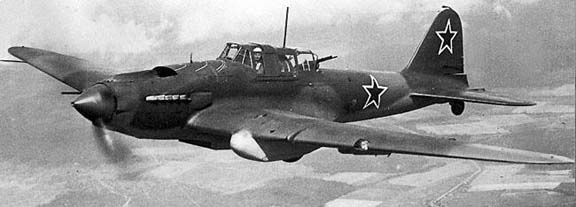A heavily armored ground-attack monoplane, the backbone of the Soviet ground-attack units in WWII. Its deadly efficiency originated not only from powerful weapon, but also from unprecedented (and for years not overcome) armoring of all vital elements: pilot cockpit, engine, cooling system, internal bomb bays. Other earlier and contemporary aircraft (with few exceptions) had armor as a addition to the airframe, and suffered from its passive weight.
In case of the Il-2 armor became a part of aircraft structure, carrying substantial part of structural functions. This resulted in great weight savings. Plus armor itself was specially designed to withstood small caliber (and so fragile!) shells, bullets and shrapnel. This protection allowed pilots to perform multiple bomb/strife runs over target area, to spend more time aiming...
General layout of the Il-2 made it maneuverable enough to allow skilled pilots to perform active air-to-air combat against fighters... Unfortunately there were not enough time for pilots to get enough training, and they had to learn it in a real combat, paying heavy toll in lives.
The first production modification of Il-2 had no rear gunner position. This was just ordered by Kliment E. Voroshilov (then Commissar and Chairman of the Red Air Force), who felt that the rear gunner position is not necessary.
Though come heavy losses from fighters in first months of the Great Patriotic War, when Il-2's were forced to operate without both escort and rear defense. Despite excellent armor and firepower of Stormovik, German fighters had enough time for multiple attacks, specially when Stormoviks were on target.
The second crewman with the gun for rear protection in production aircraft was introduced in fall 1942, in the Il-2M version. But as early as in May-June 1942 some regiments started to improvise with rear gunner position on their own, adopting turrets from old reconnaissance biplanes such as R-5;
Latest modifications (Il-2type3 and later) had slightly reshaped wing to compensate center of gravity shift, caused by added gunner and machinegun. Gunner's position was not specially armored, and despite good protection from front fire by pilot's cockpit, gunner's combat life was in average 7 times shorter than pilot's or plane's ones....
As Shturmovik pilots skills grew with time and more efficient tactics (the circle) was developed, losses went down considerably. During 1943 only 2.8% were lost during missions, despite 50% of aircraft returned to the bases with some damage. 90% of damaged Il's were repaired at the front - thanks to simple design and armor protection of all vulnerable parts. There were serious ground crew complains against wooden wing sections: enemy shells make holes like 1 square meter... and it takes too much efforts to fix! What other aircraft of this class can claim such a 'complains'?
More Links:
References:
"History
of aircraft construction in the USSR" by V.B.Shavrov,
Vol.1 p.75-77;
|
Technical information |
